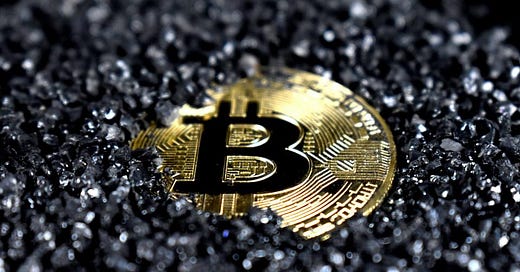Read Part 1, Part 2, Part 3, Part 4 and Part 5 if you haven’t already.
I cannot emphasize enough, how we are on the brink of a technological revolution that will fundamentally alter the way we live, work and relate to one another. This web 3 phase that we are entering or the fourth industrial revolution that we are into is like its predecessors.
This should be the most peaceful and least damaging to the universe. It will be also the most challenging and very impactful to humankind. In this context, I would like you to revisit my four-part series on Gutenberg to Blockchain - 1, 2, 3, 4. I sometimes just reread it again as it gives me better affirmation. I highly encourage you to do it too.
The first industrial revolution used water and steam power to mechanize production. The second used electric power to create mass production. The third used electronics and information technology to automate production. Now a fourth industrial revolution is building on the third, the digital revolution that has been occurring since the middle of the last century. It is characterized by a fusion of technologies that is blurring the lines between the physical, digital, and biological spheres. What is unique about this revolution is that the speed of current breakthroughs in innovations has no historical precedent.
When compared with previous industrial revolutions, the fourth is evolving at an exponential rather than a linear pace. It is disrupting almost every industry in every country. The breadth and depth of these changes will lead to a large transformation of entire systems of production, management, and governance.
A classic example is India. Can you believe 40% of all digital transactions in the world last year originated or terminated in India? This is despite India being a third-world country.
One of the biggest challenges that are facing the world is how the advancement in technology is utilized for the benefit of all rather than a few. The governance and regulations are much slower to catch up with these changes and it is creating a lot of friction.
In short, there has never been a time of greater promise, or one of greater potential peril. Today’s decision-makers, in many ways are trapped in traditional, linear thinking, or too absorbed by the multiple crises demanding their attention, to think strategically about the forces of disruption and innovation shaping our future.
Our focus currently is mostly on the financial sector. This is the sector that will still continue to widen the gap between the rich and the poor. The informed who will act judiciously and intelligently will be richer and the less informed will be more poorer. But it is also an opportunity for the less privileged and less affluent to make it big provided they do enough to educate themselves and take proper actions. The access to good information in many ways has created a level playing field for all who wish to investigate deeper and put in the hard work.
There is a major jubilee event happening. What do I mean by that? Every 50 years or so something significant happens that is related to our debt. The last one was in 1971 when President Nixon moved the US out of the gold standard and moved to a fiat system.
Ever since the GFC in 2008, we have created more debt than all the past 231 years put together. There is no way the debt can be repaid the same way that it was created.
The word jubilee is found in ancient Jewish culture. It was a Jewish socio-economic tradition. The idea was simple: at the end of 49 years, all debts would be wiped out and collateral property will be returned. See the book of Leviticus Chapter 25:8-54.
Millions of Americans are already calling for a jubilee. Some violently. The young, the poor, and the ignorant will all rally for Jubilee. There is no other way. Sensing the pulse of the public the governments will be forced to act. Otherwise, there will be bloodshed. How and what the governments can do to bring order and harmony to society will be a study in itself.
Jubilees aren’t normal default cycles. They are very different. They are debt-fueled revolutions. What happens is that debt builds and builds. Once the debt-service costs start growing faster than the economy, the total debt can never be reduced.
In a normal cycle, deleveraging reduces debt burdens. And this happens through some combination of reduced spending (to pay off debt) defaults (where assets are redistributed among creditors) and increased money supply (to prevent a deflationary spiral and stifle economic growth).
But in a debt revolution, none of these measures will work. Austerity causes a big reduction in economic growth. Spending slows and the economy declines faster than debt can be reduced. We are at such a stage now.
So what will be the solution? There will be forgiveness and a total reset to the current financial system. Blockchain will be the anchor technology that could facilitate this reset. Technologies like Bitcoin and companies like XRP and XLM will have some role to play in this. Stay tuned!
If you received value from this post, and you’d like to send some back, or if you’d like to signal to me to continue spending time on these types of explorations, feel free to buy me coffees (thank you!):
So, there we go. Thanks for reading Breezy Briefings. If you enjoyed this, I'd really appreciate it if you could take a second and tell a friend. Honestly. It makes such a big difference.
Forward this email. Recommend the newsletter. Share on Twitter, WhatsApp, Telegram, LinkedIn, Slack, wherever!
Join Breezy Briefings’ Official Telegram Channel: https://t.me/BreezyBriefings
Abraham George is a seasoned investment manager with more than 40 years of experience in trading & investment and multi-billion dollar portfolio management spanning diverse environments like banks (HSBC, ADCB), sovereign wealth fund (ADIA), a royal family office and a hedge fund. Currently, he is a co-founder of a new hedge fund where foreign citizens can invest in Indian growth stocks like Tanla operating in hyper-growth markets like CPaaS.



